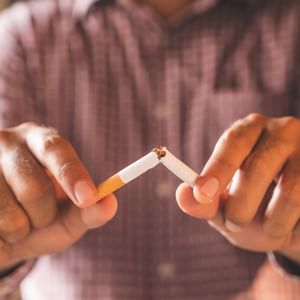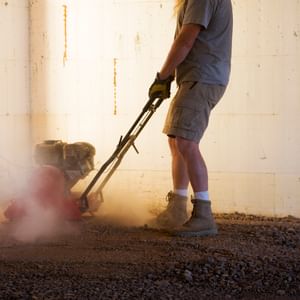National Lung Cancer Screening Program
Lung cancer screening is recommended to individuals, aged 50 to 70, who don’t currently have symptoms and have a 30-year history of smoking or equivalent.
Because lung cancer often has vague symptoms or even no symptoms in the early stages, most people are diagnosed when the cancer is advanced. Screening is the best way to find cancer early.
What is lung cancer screening?
Lung cancer screening uses a low-dose computed tomography (low-dose CT) scan to take images of your chest. It takes 10 to 15 minutes and doesn’t involve any injections or invasive procedures.
Am I eligible for lung cancer screening?
You are eligible for the National Lung Cancer Screening Program if you are aged between 50 and 70 years and:
- are asymptomatic, showing no signs or symptoms of lung cancer
- currently smoke or have quit smoking in the past 10 years
- have a history of tobacco cigarette smoking of at least 30 pack-years.
If you have any lung cancer symptoms that are unusual for you, see your doctor as soon as possible.
If you are not eligible for the National Lung Cancer Screening Program, speak with your doctor about your options.
How much does lung cancer screening cost?
The low-dose CT scan is bulk-billed, so you won’t have any out-of-pocket costs for this scan under the National Lung Cancer Screening Program.
You will need to see a doctor, nurse practitioner or Aboriginal Health Worker to get a referral for a low-dose CT scan. Healthcare providers who don’t bulk bill may charge a standard fee for the consultation. You can check what fees your doctor or healthcare provider charges when you book your appointment. You can also visit health direct to find a bulk-billing service.
Where can I have a lung cancer screening test?
If you would like to get a lung cancer screening, your doctor, nurse practitioner or Aboriginal Health Worker will give you a request for a low-dose CT scan. Ask your doctor or healthcare provider where lung cancer screening is offered in your area.
Do I have to quit smoking to be eligible for lung cancer screening?
There is no requirement to quit smoking to participate in the National Lung Cancer Screening Program.
However, quitting smoking can greatly reduce your risk of cancer, heart disease and stroke, and is highly recommended. Your lung cancer screening is a good opportunity to talk to your healthcare provider about the many supports and opportunities available to help you quit smoking.
Learn more about quitting smoking.
What lung cancer symptoms should I look for?
It’s important to see your doctor if you notice any symptoms of lung cancer that are unusual for you.
The main symptoms of lung cancer are:
- a new cough that lasts more than three weeks, or a cough you have had for a long time that gets worse
- breathlessness or wheezing
- pain in the chest or shoulder
- a chest infection that is recurring or lasts more than three weeks
- coughing or spitting up blood.
Lung cancer may also cause other and more general symptoms such as fatigue, weight loss, hoarse voice, difficulty swallowing, abdominal (belly) pain, joint pain, neck or face swelling, sweats, and enlarged fingertips (finger clubbing).
Having these symptoms does not mean that you have lung cancer – they could be caused by other conditions or from other effects of smoking – but it’s still important to have them checked by your doctor.
What increases the risk of developing lung cancer?
Risk factors for developing lung cancer include:
- Smoking - The earlier a person starts smoking, the longer they smoke and the more they smoke, the higher their risk of developing lung cancer.
- Second-hand smoke – Breathing in other people’s tobacco smoke (second-hand smoke) is known to cause lung cancer. Living with someone who smokes is estimated to increase the risk of lung cancer by up to 30 per cent in people who don’t smoke.
- Older age - Lung cancer is diagnosed mostly in people aged over 60 years, although it can occur in younger people.
- Exposure to asbestos – People who are exposed to asbestos are more likely to develop lung cancer or pleural mesothelioma. Although the use of asbestos in building materials has been banned in Australia since 2004, asbestos may still be found in some older buildings and fences.
- Exposure to silica dust – Working with materials containing crystalline silica (e.g. stone, sand, rock, bricks, tiles, concrete, artificial stone) can generate silica dust, which may cause a lung disease called silicosis when breathed in and is a risk factor for lung cancer. The use of engineered stone has been banned in Australia since July 2024.
- Exposure to other elements – People who have been exposed to radioactive gas (radon), such as uranium miners, have an increased risk of lung cancer. Outdoor and indoor air pollution (e.g. exposure to household air pollution from gas, oil, or wood-burning cooking or heating) is another risk factor. Contact with the processing of arsenic, cadmium, steel and nickel, and exposure to diesel engine exhaust and welding fumes while working may also be risk factors.
- Family history – You may be at a slightly higher risk if a family member has been diagnosed with lung cancer.
- Other medical conditions – Having another lung disease such as lung fibrosis, chronic bronchitis, pulmonary tuberculosis, emphysema or COPD (chronic obstructive pulmonary disease); or human immunodeficiency virus (HIV) may increase the risk of lung cancer.




